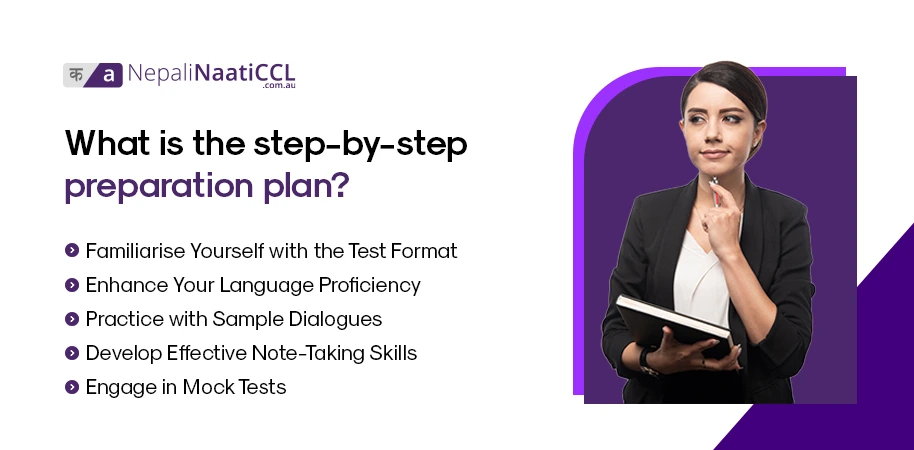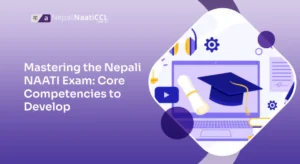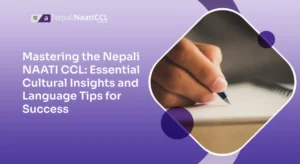The NAATI Credentialed Community Language (CCL) examination is a critical test that is designed to test the Nepali-speaking students of Australia to improve their chances of immigration.
A score of 63 out of 90 in the CCL test provides the candidates with an added 5 points in their application for Permanent Residency (PR) under the General Skilled Migration (GSM) programme. This is a detailed plan to prepare for the Nepali CCL test successfully.
Understanding the NAATI CCL Test
The NAATI CCL test determines the skills of a candidate to understand a conversation between an English speaker and a Language Other Than English (LOTE) speaker, in this case Nepali.
The test consists of two dialogues that take about 300 seconds each and centre on real-life situations like healthcare, legal and community services. These dialogues have to be interpreted sequentially, and this proves that the candidate is competent in both languages.
What is the step-by-step preparation plan?

1. Familiarise Yourself with the Test Format
It is vital to know the test structure. The NAATI CCL test entails the comprehension of recorded dialogues, which are played during the test. The candidates have to listen to the conversation and decode it most accurately and fluently. Familiarisation can also be used to reduce anxiety and help with performance.
2. Enhance Your Language Proficiency
A good command of Nepali as well as the English language is required. Pay attention to the development of your vocabulary, particularly in the spheres related to community services, healthcare, and the legal context. Reading frequently, listening to podcasts, and talking can make a great contribution to enhancing your language level.
3. Practice with Sample Dialogues
Use available materials to train in interpreting conversations. NAATI has downloadable practice materials in different languages, such as Nepali, that can be useful during preparation.
4. Develop Effective Note-Taking Skills
The candidates can take notes during the test. It is possible to come up with a system of shorthand or symbols, which will be useful to capture major information in a short time and in the most accurate manner. To master this, practise taking notes while listening to conversations.
5. Engage in Mock Tests
Taking mock tests is a simulated test setting, and it helps in fostering confidence and also shows where improvements can be made. Several sites have mock tests and practice sessions, which are regular in Nepali.
Recommended Resources for Nepali Students
Nepali NAATI CCL is a special and bilingual online coaching site which targets the Nepali-speaking candidates in Australia who want to score the necessary mark in the NAATI CCL exam and gain the additional five points to obtain an Australian permanent residence.
On this site, they note that they focus on a 100% success-oriented coaching technique and note that more than 3,000 students have placed their trust in the service.
Their course design is flexible: self-preparatory packages provide access to dialogues, vocabularies and lessons during 8 weeks; crash-course options allow covering it in 4 weeks; unlimited practice packages will suit those whose knowledge base is incomplete; and refresher packages will be able to sharpen their skills in advance before the exam.
They have many features such as 1-to-1 live coaching, daily mock tests, predictive dialogue questions, and a comprehensive learning portal (including 5,000-plus vocabulary, 700-plus PDFs, 500-plus dialogues and more) in order to address all the bases of test preparation.
Another point they make is the convenient element; when everything is online, you have the chance of studying in the comfort of your time, and the one-on-one sessions can be arranged when it fits your time and schedule, which is perfect in case you are a working student or have limited time.
Overall, Nepali NAATI CCL provides an organised, customised and adaptive approach to the Nepali students in Australia who would like to pass the Nepali NAATI CCL exam.
What are the Common Mistakes to Avoid?

1. Relying Solely on Memorisation
Memorisation is one of the greatest errors that students make when they are preparing to take the CCL test. Although it may appear to be advantageous to memorise conversations, or even set expressions, the test measures what you can do in the real instant of understanding what you hear.
Each conversation in the test might have minor differences, and memorised answers might not apply to the situation, which can lead to mistakes. Rather, try to figure out the ideas, the purpose, and the meaning of the sentences. This will assist you in passing the right meaning in Nepali, although the words may vary a little in the conversation.
Comprehending and interpreting, as opposed to memorising, is the way to be flexible and be ready to deal with unanticipated variations in the exam.
2. Ignoring Cultural Nuances
When translating between the English and Nepali languages, cultural knowledge is essential in translation. In English, most expressions or terms are culturally connotative or context-dependent, and some of them cannot have a direct word-to-word translation in Nepali.
These subtleties should be taken into consideration because otherwise a lack of meaning or clumsy wording may ensue. e.g. knowledge of politeness, formal language, or tone usage in some situations will make you understand the speaker well.
With the knowledge of the cultural differences and common communication styles in society, healthcare, or law, you will be able to create an interpretation that is not only linguistically accurate but also culturally sensitive.
3. Neglecting Consistent Practice
Interpreting is an art that can only be perfected by practising. It is one of the mistakes that many students make: they do not give the practice a day of strict focus, and they go out to take the test unprepared, to find it fast and accurate.
The training with sample dialogues, mock tests, and simulation of real-life conversations enhances listening, comprehension, and interpreting capabilities.
Also, frequent practice contributes to the building of confidence, the decrease of anxiety, and the effectiveness of note-taking during the real test. Even well-trained vocabulary and grammar students can be incapable of working in a test situation unless they practise.
What are the tips for success?

1. Consistency is Key
Consistency is one of the most significant considerations in the preparation for the NAATI CCL test. It is also helpful to reserve some time in a day to practise and interpret, learn vocabulary and read dialogues to create a good basis in the long term.
It is quite possible that shortened time spent on the study per day (including 30-60 minutes of focused work) can be more effective than the long-term, intermittent sessions of study. This can be improved over time, and gradually your brain will adjust to the need to change to English or Nepali until you become more proficient and tolerable.
It also helps to remove the stress of last-minute, as by the time the test arrives, you will be ready and guaranteed anyway.
2. Seek Feedback
Feedback should always be sought. The isolation environment may not reveal mistakes and things to work on, and hence the presence of someone like a teacher, mentor, or study group may enable you to learn a lot by sharing your interpretations.
Positive feedback will help you identify what you lack in terms of vocabulary, grammatical errors or phraseology. This type of feedback, which you willingly contribute to your practice life, will allow you to sustain the skill refinement process to ensure that what you interpret is clear, accurate and culturally appropriate.
3. Stay Calm During the Test
It is important to remain calm when taking the exam in order to provide correct and fluent interpretations. Nervousness or anxiety may result in the words being missed, hesitation or poor wording. Deep breathing, positive visualisation, and concentration during a single conversation are some of the techniques that may be used to handle stress.
Calming down will enable you to be more focused on what you are talking about, remember words effectively and analyse with certainty. Relaxed concentration of the mind leads to improved performance and results.
Get Ready to Ace Your NAATI CCL Test — Join Hundreds of Successful Nepali Students Today!
Hundreds of Nepali students across Australia are achieving their NAATI CCL success and earning valuable 5 PR points. When will you take the next step?
At Nepali NAATI CCL, our mission is to ensure every student passes the CCL test with confidence through expert-guided coaching, real exam-based dialogues, and unlimited practice opportunities.
💬 Need guidance now? Chat directly with our friendly instructors on WhatsApp for personalised course recommendations and quick assistance.
🎯 Access our online platform today and start your journey towards a successful NAATI CCL result – flexible, proven, and 100% success-focused!
👉 Join Now at Nepali NAATI CCL and take the first step towards your NAATI CCL success!
Conclusion
The process of preparing for the NAATI CCL test is not only an academic undertaking but also a process of language learning, cultural awareness and self-investment. The CCL test is also a good chance to acquire five more PR points, and it also helps Nepali students in Australia to enhance their bilingual communication skills, which would help them in their future career and participation in the community. The winning of this test requires a combination of commitment, intelligent preparation and confidence.
After all, it is not the test of the NAATI CCL that is only about gaining some migration points, but it is a stepping stone towards being a competent communicator and an active participant in the multicultural society of Australia.
By having the right frame of mind, resources, and perseverance, the Nepali students can make this challenge a sweet reward that can pave their future in Australia.
FAQs
1. How to prepare for the NAATI CCL test?
To prepare for the NAATI CCL test, practice interpreting English–Nepali dialogues daily, focus on building vocabulary in common topics (health, legal, community), take mock tests, and revise with feedback from trainers or online courses like Nepali NAATI CCL for the best results.
2. Is NAATI CCL easy to pass?
The NAATI CCL test is manageable with regular practice and the right preparation. Many students pass easily with proper guidance.
3. What are the benefits of NAATI?
The main benefits of NAATI CCL are:
- Extra PR points for skilled migration in Australia.
- Recognition of language skills for English–Nepali interpreting.
- Better job opportunities in community, healthcare, and government roles.
- Improved communication skills across cultures.
4. How to get 5 points for NAATI?
You get 5 points for NAATI by passing the NAATI CCL test in your language (e.g., Nepali) with a minimum score of 63 out of 90. This adds points to your Australian skilled migration PR application.





